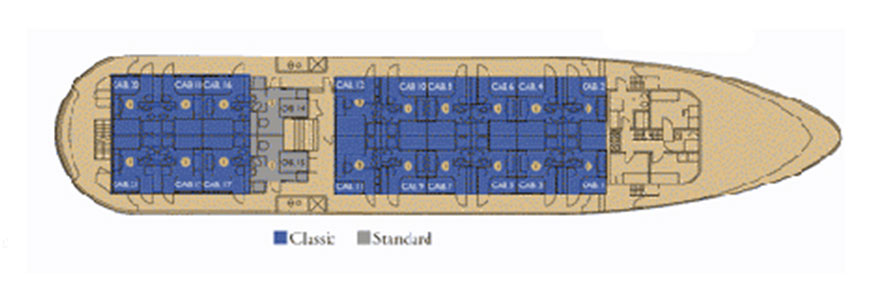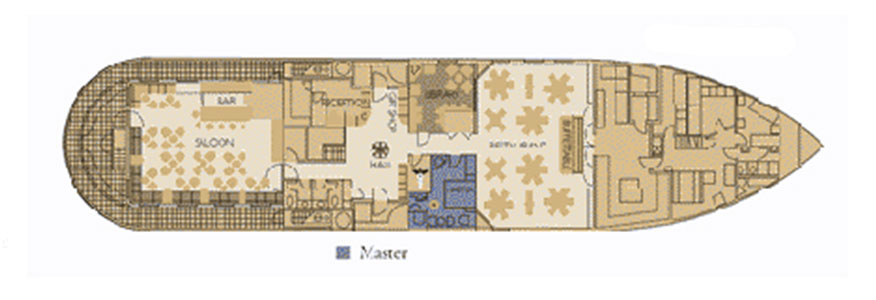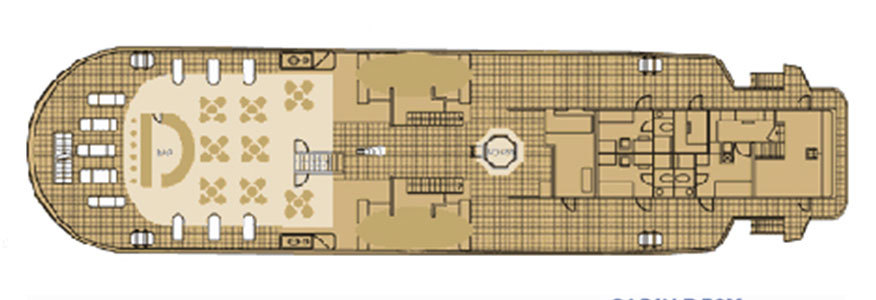Luxury Isabela II Cruise Ship
Capacity
40 guests
Speed
10 knots
Type
Motor Yacht
Length
53.72 meters (166 feet)
Decks
3 (Sun deck, Cabin deck, Main deck).
Wellness
Jacuzzi, Gym
Luxury Isabela II Cruise ship
Description
Explore the Islands with style and comfort: The Galapagos luxury Isabella II has a capacity of only 40 guests, she offers a relaxed atmosphere while enjoying an unforgettable Galapagos expedition, where guests fully experience their sense of discovery and bonding with nature. ISABELA II expeditions offers all aspects of the Galapagos: an intimate contact with wildlife, active volcanoes, a vast Marine Reserve, adventure, comfort and safety.
Our Galapagos luxury Yacht ISABELA II offers the most in-depth week itinerary (Tuesday to Tuesday) allowing guests to enjoy all that Galapagos is famous for: from ancient giant tortoises to penguins, from sleek flamingos to bold sharks, from bizarre flightless cormorants to rugged marine iguanas and from whales and dolphins to dramatic island volcanoes and breathtaking scenery, plus the exploration of the Galapagos Marine Reserve (the second largest in the world) on kayaks, the glass bottom boat, swimming or snorkeling.
The expertise of three English-speaking Naturalist Guides matches their contagious enthusiasm, whether discussing geology or bird watching, snorkeling or stargazing, evolution or marine actitivies. Guests of ISABELA II have the opportunity to explore the islands in small groups with fellow enthusiasts who share their same passion for nature, curiosity and spirit of observation.
Packing Check List:
- Small backpack (waterproof), Comfortable walking shoes
- Sneakers with rubber soles, Shorts
- Long pants, T-shirts, Long and Short sleeved shirts
- Wind breaker, Bathing suit -wetsuit for snorkeling in cold months
- Socks, Underwear, Hat or cap, Toilette kit (biodegradable shampoo please)
- Sun block, Sunglasses, Binoculars, Camera & camcorder
- Any medicine you may be taking, Book/ Notebook
Important Information
Luggage: No more than 20 Kilos (44 pounds) of luggage (one suitcase) may be checked on flights to or from the Galapagos Islands.
Additional luggage may be stored at your hotel. These restrictions do not include small carry-on flight bags or camera cases.
Cruise attire: For travel in the Galapagos, clothing ranges from informal to very informal. Essentials include sneakers, shorts, long- and short-sleeve lightweight shirts, bathing suit, a wide-brimmed hat, long pants, and a wind breaker or light jacket for evenings. Be sure to bring sunscreen, sunglasses and lots of film.
Shoes: Most walking ashore is over rocky lava terrain. Therefore tennis shoes, sneakers or walking shoes with rubber soles must be worn.
Climate: The Galapagos Islands are located on the equator. The tropical heat, however, is tempered by Pacific breezes.
There are two seasons in the islands: the rainy, hot season from December to June when humidity is high and average temperatures are in the 80s F (26°-30° C). There may be occasional showers, but the days are generally hot and sunny.
From June to November, you can expect cool winds, ocassionally bringing with them a light misty-type drizzle called «garúa.» Temperatures average in the 70s F (20°-24° C) during the day and lower at night.
Passports: Passengers must travel to the Galapagos with their passports.
Passport numbers must be furnished one month prior to arrival.
Galapagos National Park admission fee
US$100 per person. It must be paid upon arrival at the airport in Galapagos (rate is subject to change without notice).
Electric current: 110/AC. Electric shavers and hair dryers can be accommodated.
Local time: GMT minus 6 hours in the Galapagos Islands. GMT minus 5 hours on mainland Ecuador.
Purchases on board: US dollars or travelers cheques may be used on board. Credit cards (Visa, Mastercard and American Express) are also accepted.
Safety: All safety and fire prevention measures have been implemented on all vessels. There is a resident physician aboard ISABELA II. Life jackets are mandatory for all «panga» rides (outboard motorized Zodiacs).
Meals: Breakfast, lunch and dinner are included. Wine, beer and soft drinks are extra. Bottled water is supplied in each cabin free of charge.
Included
- Accommodations, all meals, island sightseeing, naturalist guides and lecture services in English/Spanish only, snorkeling gear, taxes and transfers in the islands.
- Shared transfers from main hotels in Quito (Casa Gangotena, Hilton Colon, Swissôtel, Marriott, Dann Carlton) and in Guayaquil (Hilton Colon, Oro Verde, Hampton Inn, Sheraton) to airport for flights to / from Galápagos are included in these rates. To coordinate these transfers we must have guest's hotel contact.
Excluded
- Wet Suits available for rent, NET rate $ 15 + VAT per guest for 5-day expeditions.
- Wet Suits available for rent, NET rate $ 30 + VAT per guest for 7-day expeditions.
- Air transportation to / from Galápagos and airport taxes (subject to change without previous notice).
- Galápagos National Park entrance fee (US$ 100 subject to change without previous notice).
- Migration Control Card (US $ 20 subject to change without previous notice).
- Alcoholic and non alcoholic beverage, gratuities, gifts and additional items.
- Internet / Wi-Fi
Starting
$ 0.00
/ pack
Book This Tour
Itineraries
Day 1: Monday
Baltra Airport and Santa Cruz Island
After landing at Baltra Airport, we drive to the Itabaca Channel to take a ferry across to Santa Cruz Island. A 30-minute bus ride takes us up to the fascinating, more humid Highlands of the island where we’ll learn about its unique ecosystems and biodiversity. Lunch will be served at a local restaurant.
Note: Please dress with comfortable shoes and clothes, bring a small backpack with any medicine you might be taken, sunblock, insect repellent, and anything you need during the excursion. You’ll go onboard Yacht Isabela II at the end of the day.
Santa Cruz Island’s Highlands and Puerto Ayora
After lunch, we drive to a nearby reserve that is one of the best places in the archipelago to see giant tortoises in their natural habitat. The tortoises are easy to spot, lumbering around, munching on grass and leaves, and wallowing in small pools. There are several lava tunnels to explore in the reserve, too. A short bus ride takes us down to Puerto Ayora to board the Isabela II.
Day 2: Tuesday
Puerto Egas (Santiago Island)
Following a wet landing on the black, sandy beach, our trail takes us to enjoy close-up encounters with recently reintroduced land iguanas, plus land and marine birds amid a landscape of tuff-stone layers, jagged rocks, and lava flows. At low tide, marine iguanas graze upon the algae beds. We can also observe a colony of fur seals, usually dozing in the shade of some rocks.
Chinese Hat Islet
This islet, formed only relatively recently, makes a wonderful afternoon visit as we explore the wildlife along its 1,312 ft long (400 m long) trail, which begins at a crescent-shaped, white sandy beach. The cove offers excellent swimming and snorkeling opportunities amid white-tipped reef sharks and Galapagos penguins.
Day 3: Wednesday
Prince Philip’s Steps (Genovesa Island)
The day kicks off with a panga ride along the cliffs of “Bird Island” as Genovesa is affectionately nicknamed, followed by a landing at a steep staircase that connects us with a flat plateau. From here, the trail winds its way through large colonies of Nazca boobies, red-footed boobies, great frigatebirds, and storm petrels. With luck, we’ll be able to spot the short-eared owl. Those who do not wish to disembark can enjoy a longer panga (inflatable dinghy) ride along the cliffs, weather conditions permitting. Snorkeling and kayaking activities are available.
Darwin Bay (Genovesa Island)
We land after lunch at the beautiful white beach of Darwin Bay. Here we walk amid literally hundreds of birds, most of which are frigatebirds, red-footed and Nazca boobies, as well as gulls, herons, finches, and mockingbirds.
Day 4: Thursday
Santa Fe Island
We take the dinghy over to this idyllic sandy-white beach populated by colonies of sea lions. Galapagos hawks are often easily observed, perched atop salt bushes. The Santa Fe land iguana may be spotted during our exploration. Following the walk, we can snorkel and swim along a natural wave barrier or ride the glass-bottom boat.
South Plaza Island
Following lunch and a rest, we disembark (dry landing) in this channel, whose turquoise waters contrast brilliantly with the white sand and black lava of the shoreline. Beyond, a carpet of scarlet sesuvium succulents serves as a groundcover for a grove of luminescent green prickly-pear cactus. Yellow-grey land iguanas sit beneath these, waiting patiently for pears to drop. Along the coastline we find sea lion colonies, while frigates, swallow-tailed gulls, and shearwaters glide, playing with the thermals.
Day 5: Friday
Baltra Island
Our journey ends at Baltra Island where we transfer to the airport to take the flight back to the mainland.
Day 1: Thursday
ABaltra Airport (Santa Cruz Island)
After landing at Baltra Airport, we drive to the Itabaca Channel to take a ferry across to Santa Cruz Island. A 30-minute bus ride takes us to a restaurant in the fascinating, more humid Highlands of the island to enjoy lunch, and then continue south down to Puerto Ayora on the coast.
Puerto Ayora and the Charles Darwin Research Station
At the eastern end of Puerto Ayora, the largest town in the archipelago, we visit the Charles Darwin Research Station and the Giant Tortoise Breeding Center, the islands’ headquarters for scientific research and conservation. Later in the afternoon, we stroll along the main street of Puerto Ayora before embarking. Captain’s welcome cocktail and dinner.
Day 2: Friday
Bartolome Island
This morning, a Galapagos icon awaits Bartolome Island. A great way to start the day, with a steep climb up a wooden staircase: the panoramic view from the top is well worth the effort! Following the walk, we take a panga ride around colossal Pinnacle Rock in search of Galapagos penguins and other wildlife.
Sullivan Bay (Santiago Island)
After lunch, we board the pangas (inflatable dinghies) and land at Sullivan Bay on the east coast of Santiago, a white coral sand beach that is ideal for swimming. A trail runs along a lava field that flowed here around 100 years ago. This is the perfect place to see and understand the volcanic origin of the Galapagos.
Day 3: Saturday
Dragon Hill (Santa Cruz Island)
The north coast of Santa Cruz hosts the fascinating landscapes of Dragon Hill. After disembarking, the first part of our walk passes a brackish-water lagoon frequented by shorebirds, ducks, and American flamingos. Further inland, the trail offers a beautiful view of the bay and the western islands of the archipelago, as well as the chance of observing land iguanas (for which the visitor site is named, following a concerted effort to conserve them by the Galapagos National Park). After our walk, we can snorkel from the shore, hoping to spot rays, green turtles, and sharks.
Buccaneer Cove (Santiago Island)
After lunch, we explore the coastline along the impressive cliffs of Buccaneer Cove, learning about the area’s distant and recent history. The cove is home to a large number of marine birds, sea lions, and inter-tidal organisms. Enjoy fantastic natural formations such as the “Elephant Rock”, “The Bishop” and an impressive natural cave. Opportunities for snorkeling and a ride on the panga or glass-bottom boat are available.
Day 4: Sunday
Punta Vicente Roca (Isabela Island)
Since there is no landing site at this location, we explore the captivating coast by dinghy, seeking out abundant wildlife including colonies of Galapagos fur seals, the nesting sites of Nazca boobies, not to mention flightless cormorants, penguins, and marine iguanas. Depending on the conditions of the ocean, we’ll be able to snorkel along the cliffs, hopefully in the company of green sea turtles. Back on board, we navigate along the Bolivar Channel, where nutrient-rich upwellings provide fertile fishing grounds for cetaceans.
Punta Espinoza (Fernandina Island)
We end our journey on a high note by visiting the island of Fernandina, the youngest island of the archipelago, and arguably one of the most pristine ecosystems on the planet. Our visitor site of Punta Espinoza boasts a fantastic combination of apparently barren landscapes and abundant wildlife, all dominated by the lofty volcano at the heart of the island. Highlights to spot include hawks, penguins, vast numbers of marine iguanas, and the famous flightless cormorant, with its beguiling blue eyes.
Day 5: Monday
Baltra Island
Our journey ends at Baltra Island where we transfer to the airport to take the flight back to the mainland.
Day 1: Friday
Baltra Airport and Santa Cruz Island
We land at Baltra Island by plane in the morning and transfer to the nearby dock to board Yacht Isabela II, where we receive a welcome introductory briefing, boat drill, and lunch.
Las Bachas (Santa Cruz Island)
This beautiful visitor site is located on the north shore of Santa Cruz Island, a glorious white beach with a couple of brackish lagoons only a few steps away from the sea. These lagoons are the feeding grounds of various wading birds, from stilts to flamingos. You may enjoy swimming at this beach, too. Back on the ship, we will settle in with a welcome cocktail, a briefing on the next day’s expedition plan, and a delicious dinner.
Day 2: Saturday
Punta Pitt (San Cristobal)
We land on the eastern tip of the island. The trail that ascends from the beach provides spectacular views of the shoreline and is the only site in the Galapagos where the 3 species of boobies can be found together, as well as the two frigatebird species, plus a colony of bachelor sea lions. If conditions are favorable, there is a chance to swim, kayak, or snorkel from the beach or take an inflatable dinghy ride.
Cerro Colorado (San Cristobal Island)
We disembark at Puerto Baquerizo Moreno and drive 40 minutes to the island’s southern shore. At Cerro Colorado, we visit the breeding center for highly endangered giant tortoises amid a fantastic deciduous forest, home to dozens of bird species, including the San Cristobal mockingbird, as well as the endemic San Cristobal lava lizard.
Day 3: Sunday
Gardner Bay (Española Island)
In the morning, we’ll set foot on this beautiful, white coral beach and go on a short walk to observe the sea lions, mockingbirds, finches, or enjoy the beach. There is excellent snorkeling in this area. Kayaking, an inflatable dinghy-ride, or a ride on the glass-bottom boat are also offered.
Punta Suarez (Española Island)
Following lunch on board, our afternoon outing at Punta Suarez takes us on an exciting trail across lava/boulder terrain. Along the way, we can enjoy unique sea bird colonies, including the beautiful waved albatrosses, boobies, swallow-tail gulls, and the famous “blowhole”. This island is also renowned for its colorful and sizable marine iguanas. All in all, a wonderful visit.
Day 4: Monday
Cormorant Point (Floreana Island)
We disembark in the morning at the curiously green-tinged, olivine-crystal beach that makes for an easy walk to a brackish water lagoon where bird species like American flamingos can be observed. Crossing over to the other side of the island, we come to a white-sand beach where sea turtles come out at night to nest. At Champion Islet, guests can choose between snorkeling, a panga ride, or a ride in our glass-bottom boat.
Post Office Bay & Baroness Cove (Floreana Island)
After lunch, we land at Post Office Bay to visit the historic barrel that has served as an informal post office in the archipelago for over two centuries. Snorkeling off the beach will be offered afterward.
Day 5: Tuesday
Punta Moreno (Isabela Island)
In the morning, following a meander through the mangroves in search of sea turtles, we disembark amid a landscape dominated by the giant volcanoes of southern Isabela Island, some still active. The rugged trail loops inland from the coast, giving us plenty of opportunity to enjoy unique lava formations, pioneer lava cactus, and exotic scalesia trees, as well as plenty of wildlife: Galapagos penguins, flightless cormorants, brown pelicans, herons, sea lions, marine iguanas, and dozens of Sally Lightfoot crabs. The inland lagoons are home to Bahama-pintail ducks, common stilts, Galapagos flamingos, and even Galapagos hawks and mockingbirds. Following our walk, we can take to our glass-bottom boats or deep-water snorkel.
Punta Mangle (Fernandina Island)
In the afternoon, we’ll explore Fernandina’s coastline aboard our pangas (inflatable dinghies). The archipelago’s youngest ecosystem is home to small Galapagos penguins and green-eyed flightless cormorants that rest on the shore’s black rocks. Beneath the waves, rays and sea turtles might glide by. The nutrient-rich waters of the Bolivar Channel, which separates Fernandina and Isabela islands, attract dolphins and whales. With luck, we’ll be able to spot them. Depending on sea conditions, we end our visit with a glass-bottom boat ride or deep-water snorkel.
Day 6: Wednesday
Eden Islet
A panga ride takes us to Eden Islet, located off the coast of Santa Cruz, where we can observe blue-footed boobies, reef sharks, and frigates. There’s a chance to snorkel and, if weather conditions permit, to ride in the glass-bottom boat. The volcanic setting of this area is quite stunning.
North Seymour Island
We have saved one of the best visitor sites in the archipelago for last. In the afternoon, we disembark for a walk along the coast and the interior of this beautiful flat island. We’ll be able to see numerous nesting frigatebirds as well as land iguanas and sea lion colonies along the coastline. We can explore the coast by dinghy, too, seeking out fur seals, and enjoying a fun, deep-water snorkel. Evening briefing, farewell cocktail, and dinner.
Day 7: Thursday
Baltra Island
Our journey ends at Baltra Island where we transfer to the airport to take the flight back to the mainland.
Deck Plans
Gallery
La Pinta Luxury Yacht
Company
Contact Us:
- Address: Checoslovaquia E9-95 St., Eveliza Plaza building. Quito-Ecuador
- jorge@exclusiveecuador.info
- TOLL FREE USA & CAN 1-866-454-9060
- TELEPHONE UK +44-2033-724723
- TELEPHONE ECUADOR +593-2-333-3718
- MOBILE ECUADOR +593-99-281-3776




